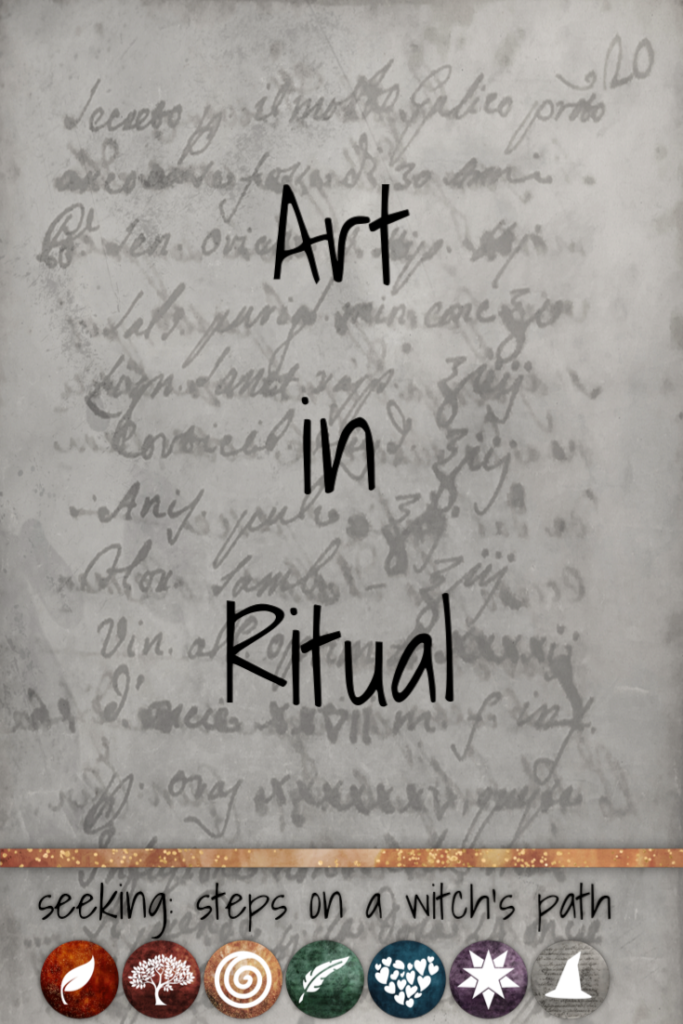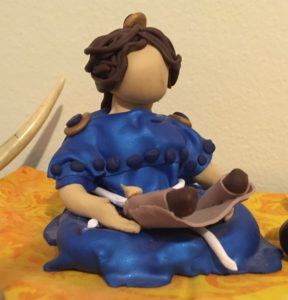There are many different ways to use art (or objects that are also art) in rituals – but how do you get started? And what can you do with some simple items if you don’t have much to start with? This article has ideas and practical options.

Why?
Before we talk about specific art, you are probably wondering why you might want some. One very simple reason is that it’s pleasing to many people – it draws the eye, makes us happy, brings us joy. Good reasons to do things! But there are other reasons you may want to include art or artistic elements in your practice.
Colour: One incredible use of art and symbol in ritual has to do with colour. Many traditions and groups have colours associated with each quarter, so that when you turn in that direction, there are objects and choices that reinforce each other – and that are also beautiful to look at, and engage your senses. Over time, these build up into sets of associations you can use to make your ritual and magic flow more easily – not a bad thing.
Devotion: Many of our deities like beautiful things (like people do). Offering a piece of art or sculpture or jewelry can be a gift or a connection to a specific deity or other being.
Holding a commitment: Some traditions use a piece of jewelry as a physical token for an oath or commitment. Sometimes that may be short, just for the duration of a goal. Sometimes it may be a long-term oath (like initiation) The pieces we choose for these uses have some practical considerations (depending how we’re going to use them – something we’re going to wear all the time even in the shower needs to be okay getting wet, for example.) But there are also often good reasons to pay attention to the symbols and design of the object – the qualities that make it art.
Focus of intention: Of course, one big use for art is to give us a focus for our intention. This can be art someone else made. Many people use Tarot card decks to represent elements when casting circle – especially if other tools are limited. Or it can be art you make, with symbols, colours, and designs that speak to you and your goals.
Art, objects, and uses
Altar items and representations
Some of the most common art objects people use are ritual statues. These might be statues of specific deities, or they might be symbolic representations of particular concept or desire. (For example, a simple piece of rose quartz carved into a heart or other symbol is art, but it’s also a representation. You can buy many deity representations at Pagan stores online and offline (or at events).
For less common deities or other representations, it’s also possible to make your own from materials like polymer clay or self-hardening clay. This image is a devotional statue for Hypatia of Alexandria, who I honour as an ancestor of profession.
Altar tools
Many altar tools are works of art in their own rights. Sometimes these can be fairly simple – an elegantly decorated wand, a simple but beautiful chalice. But sometimes they’re much more elaborate. These are things that most people build up over time, over years or decades, so don’t worry if your current tools (whatever you’re using, if you are) are very simple. Those can be beautiful too.
The photo below is of three ritual blades in my collection – the top one is pretty plain with a black leather grip, the bottom one was a gift from a dear friend who’d gotten it while working at the Minnesota Renaissance Festival, and wanted to find a home for a ritual blade she was no longer using, with a hilt made of antler bone and some lovely work joining the blade.
The centre one is indeed a work in art: it was a commissioned blade made by Omega Artworks. There’s lots more about that process here.
You can see other examples of altar tools in my article about my altar.
Creating art
One technique that doesn’t get talked about a lot is actually creating art in ritual.
One ritual in my past group work experience had the group painting words on a large canvas (big enough for several people to work on at once) that reflected goals for the coming year. Everyone got to contribute. Once that was done, everyone collaborated on a larger design, with acrylic paints (they dry faster)
Another example is something I do for ongoing workings. I create a design with symbols that make sense for me and that working. I do a sketch or five in pencil to figure out specific elements and layout, then do a full size one. I trace it in pen, add colour with watercolour pencils (I have a set of the Inktense ones, which are very vibrant
Then when I’m ready, I activate the whole thing by going over it with a brush and clean water. That extra step makes it much easier to focus on the intention without worrying about the art.
I like Symbols.com for ideas for symbols – it’s also a great resource if you half remember a symbol and are trying to track it down, since you can search based on specific elements or features in their Graphical Index)
Browsing Wikipedia for things like alchemy, astrology, or other magical symbols can give you ideas too (just make sure to research new symbols carefully, so you don’t include unexpected meanings!)
Also, don’t ignore the fact that craft stores have a lot of inexpensive but great art objects. I’ve decorated small boxes for the four elements (with small objects inside – these can be a great elemental mini-altar).
Some people create portable altars or shrines out of small tins (like Altoid tins). Some people keep elaborately decorated magical journals. (I’ve been doing sketches of a series of meditations in black pen and Zebra Midliners, a brand of highlighter that are more muted colours)
Tarot and divination cards:
We often focus on Tarot and divination cards for their use as a tool, but they’re also incredible pieces of art in many cases. There are many different ways to use them ritually:
- To represent an element on a quarter altar. Most commonly people use the Ace of each suit of cards.
- To represent a goal of a working or ritual. In this case, pick a card or cards that have symbols or goals.
- For spell working of other kinds.
I set up my wallet with simple color printouts of cards from my favourite deck, put in wallet-card size lamination envelopes. They live in my wallet, with sigils for prosperity and well-being. I can swap them out easily if my focus changes, and it’s quick and easy to pull one out whereever I am if I need a reminder.
If you want to get a sense of different decks, Aeclectic Tarot has a great directory of different ones, and shows a good selection of sample cards. (Lots of Tarot and card divination bloggers also do in-depth deck reviews.)
Wallpaper on phones and computers
One of my most common uses for art is to set a background on my phone and computer that echoes my current long-term magical goals or ritual focus. The last two years I’ve picked a word to focus the year, and included it on a phone background, so every time I open my phone, I see it. (You can also do this with symbols or whatever else makes sense to you.)
What I love about this is that it just has to be meaningful to you. If you’re somewhere where other people may see your screen or your phone, you can pick an image that matters to you, but is just a beautiful photo or art to them.
Unsplash is a great source of images you can use or adapt freely. If you’re not great with design, Canva has some great layout options (and a number of free resources, and others you will need to pay a small fee for)
Jewellery
Finally, there are all kinds of beautiful artistic things you can wear. Many people find wearing something that is personally meaningful a great way to carry their intention through the day. For some people, this can be an obvious religious piece like a pentacle or triskelion. But there are also many great options out there for pieces that are meaningful to the individual but not obviously Pagan (great if you work somewhere that could be a distraction, or where obvious religious jewelry isn’t allowed).
I have a selection of pendants I’ve picked up over a number of years, and I pick one to wear depending on my mood, what the day involves, and what I’m currently focusing on or thinking about. Some of my pieces are deliberately designed as magical tools, others just are a useful mental focus.
Learn more about ritual jewellery.

Last edited February 8, 2018. Reformatted November 2020.





